To effectively market your care home you need to appear highly on Google.
This means appearing highly in either the paid ads or the organic listings.
Ideally, both.
- Google Ads PPC
- Search Engine Optimisation (SEO)
In this article, we will show you how to get your care home at the top of the page on Google with SEO and Google Ads PPC.
We will also show you how to maximise engagement and lead generation from that traffic with Conversion Rate Optimisation (CRO).
In a nutshell – This is a comprehensive guide detailing exactly how to successfully market your care home on the Google search engine in 2022 and beyond.
Free marketing review – if you would rather get some professional help and a free digital marketing review & plan for your care home then get in touch.
Contents
- Keyword Research
- The Search Landscape
- Google PPC Ads for Care Homes
- Local SEO for Care Homes
- SEO for Care Homes
- SEO & PPC for Multiple Care Homes
- Supportive Tactics
- Conversion Rate Optimisation
- Measuring Results
- Summary
Looking for some professional help? – request a free SEO & PPC review for your care home: free marketing review.
Read on to find out how to get your care home to the top of Google with SEO & PPC.
1. Keyword Research
Before we can improve your visibility we first need to know what keywords to target.
You should follow a structured approach here that allows you to build out a list of keywords that map to the services and locations that your care home provides.
1.1. Initial keyword list
We would generally feel that there are three primary dimensions for most care homes or care home groups to consider.
- The type of home
- The type of care
- The locations covered
This will often take the form of some initial brainstorming to formulate this basic list.
The type of home
- care home
- nursing home
- residential care
The type of care available
- residential care
- dementia care
- nursing care
- respite care
- convalescent care
The locations you cover
- Birmingham
- Sutton Coldfield
- Aldridge
Note: locations can be a little different as you may have a home in one area that covers many other surrounding areas so you will have to think this through carefully.
This is not meant to be an exhaustive list but more a means for you to research and structure your keywords in a way that makes sense.
1.2. Expanding your keyword list
Once you have your initial list you can start to conduct some basic searches on Google to help you expand this list.
By starting to search for “care homes” you will see a number of suggested keywords.
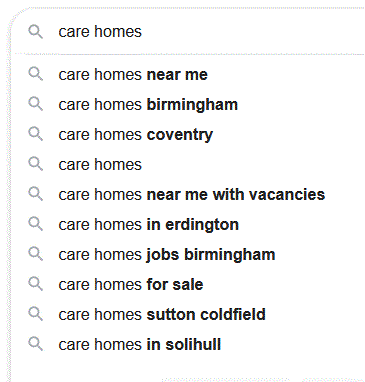
You can further refine this by adding a letter after your search, so:
- care homes a
- care homes b
- etc
This will give you other terms that you can harvest to add to your list.
Related searches
If you browse to the bottom of the search results you will also get some related searches.
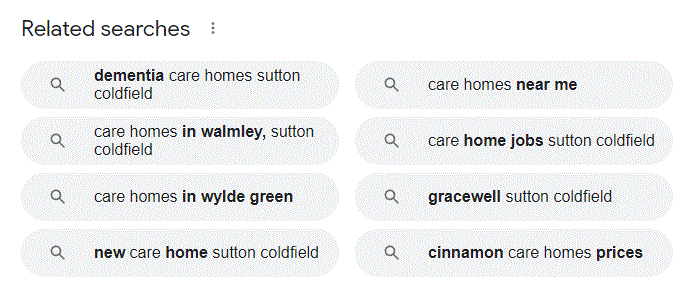
These search terms are related to the search journey and search terms that other search engine users, that is, your prospect customers, have gone on to search for.
1.3. Keyword research tools
For care homes, like most local businesses, you don’t really need keyword research tools and the approach above should be enough to get you started.
If you want to utilise some tools, Google Keyword Planner in Google Ads (1) is worth a look and gives you information from Google.
Also, the free Keywords Everywhere (2) plugin is useful for related keywords, ‘People also ask’, and long-tail keywords.
1.4. Structuring your keywords
Once you have listed all your initial keywords you may want to expand upon this list to include variations of phrases and then group these together.
Some good metrics to track include:
- Keyword
- Keyword rank
- Target page (this is how keywords are grouped)
- Search volume
- Competition
- Cost per click (CPC) in Google Ads (as a proxy for quality)
By gathering all of this information, you can rank order your keywords and group by the target page.
This gives you an easy way to keep track of progress and ensure you spend your SEO time where it will have the biggest impact.
Note: Drop me an email via our contact page and I can send over our keyword research template.
2. The Search Landscape
Armed with your keyword research, you can now conduct some research to ensure you understand the opportunities on the search engine for your care home.
There are SEO tools that purport to offer this information, however, I believe nothing beats just searching for your keywords and paying close attention to the results.
The below image shows a portion of the search results for “care home near me” which does around 40,000 searches per month in the UK.
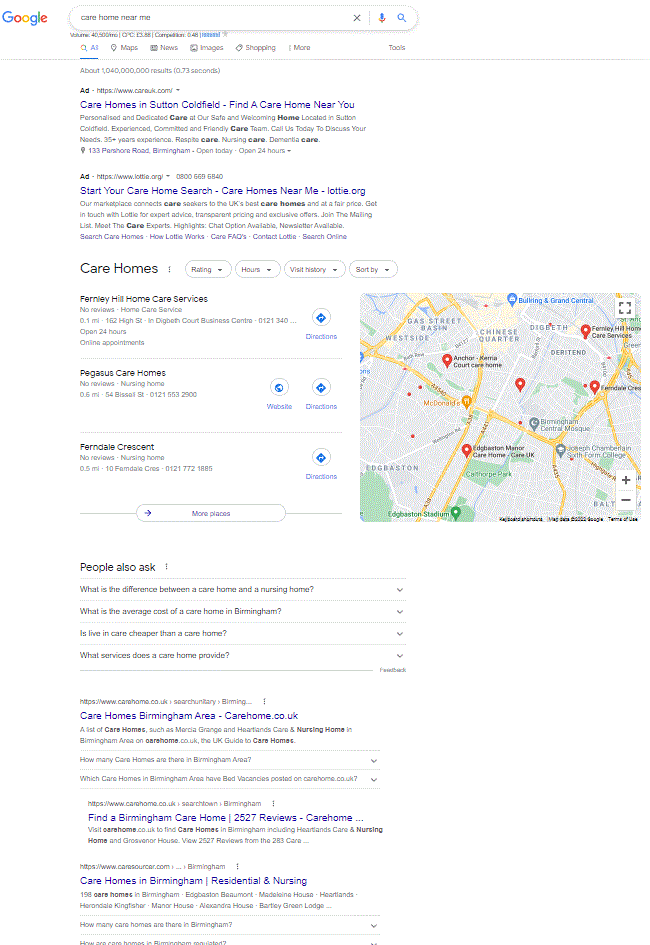
On this page we see the following results:
- 2 x Google PPC Ads
- 3 x Google Maps listings and a Google Map
- 4 x People also ask results
- 10 x organic listings (directories and homes)
- 3 x Google PPC Ads
- 4 x People also ask results (different 4 pack)
- Related searches
The key opportunities for this search term are clear:
- Google Ads – top of page
- Google Maps listings (local SEO)
- Google organic listings (SEO)
- Directory listings on third-party sites (carehome.co.uk etc)
- People also ask listings
Armed with this information, you can start to formulate a plan for your SEO that builds on each keyword.
You can then detail this in your keyword research spreadsheet (request our template here).
By following this methodical process, you can get a clear understanding of where the opportunities lie and build your SEO strategy from here.
3. Google PPC Ads for Care Homes
For the majority of “care home” searches, the top of the page is dominated by ads:
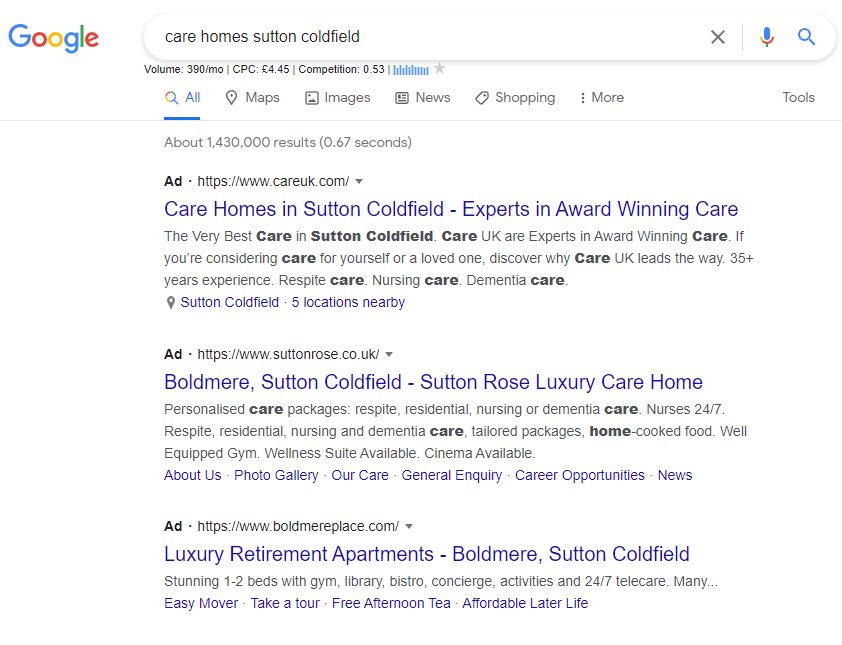
So, getting your site listed at the top of the page is going to require setting up some PPC search ads in Google Ads.
How to set up your first Google Ads PPC campaign
If you are new to Google Ads PPC then we will give you a brief summary of how to set up a campaign here.
Firstly, you need to be aware of how a Google Ads account is structured. In simple terms, we have:
- Account – billing information
- Campaign – budgets and geography
- Ad group – keywords and ad targeting
- Keywords and ads – where the rubber hits the road
The basic approach here would be to:
- Create a campaign with your daily budget and desired location targeting
- Build an ad group for “care homes” that targets that keyword and variations of *
- Create a number of ads and ad extensions that promote your care home
- Send users to the most relevant landing page
In principle, this is all there is to it, but with Google Ads, the devil really is in the details.
You must be aware of how Google Ads keyword match types work.
For your ads to succeed, you will have to optimise the keywords targeted, the ad copy, the landing pages, and carefully track conversions.
Conversion rate optimisation is also crucially important to maximise the number of visitors that get in touch.
Suffice to say, setting up your ads is easy, getting them to work at peak efficiency takes time and effort.
* variations would likely be things like “care homes”, “care homes near me”, “care homes in x”.
4. Local SEO for Care Homes
For most “care home” search queries, the second most prominent set of listings will be the Google Maps listings.
It is also of note that Google has slipped an ad into the local results as well now so your ad strategy will need to take that into consideration.
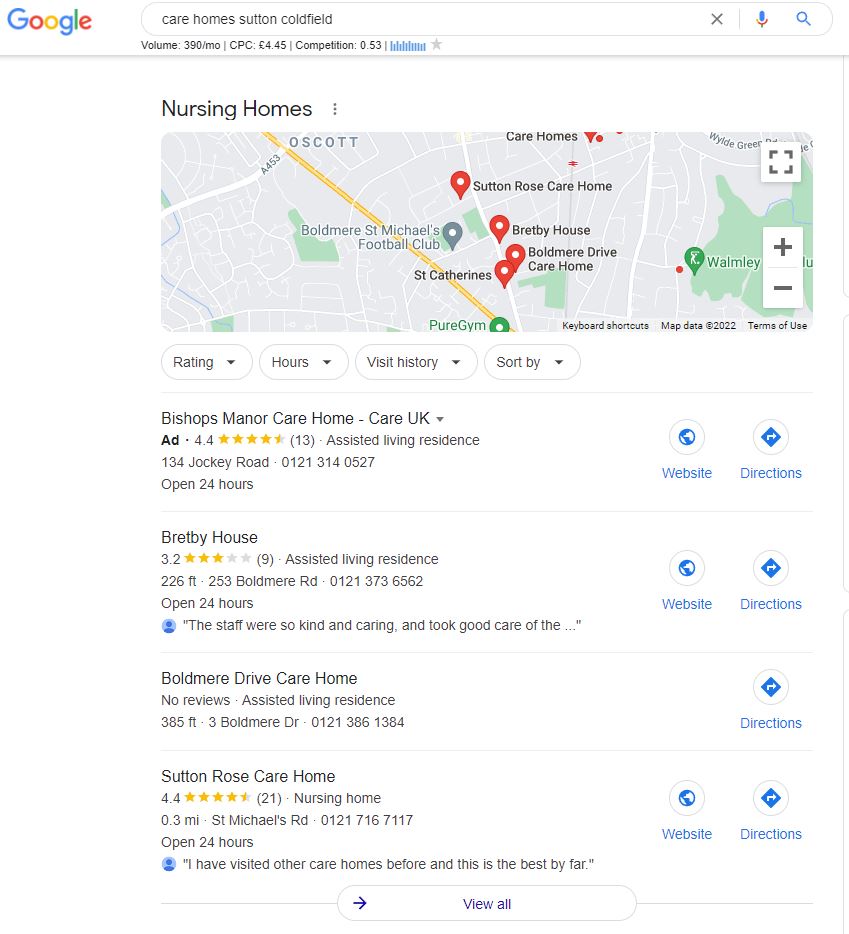
How to rank your care home locally
The process of improving the visibility of your care home in these results is known as local SEO.
The main areas of local SEO that you need to consider are:
- Optimising your website for your keywords and location
- Claiming and optimising your Google Business Profile
- Having a clear and consistent NAP (name, address & phone number)
- Building and optimising local business listings (known as citations)
- Building reputation signals with reviews
- Authority and local links
If you can get these six key areas well-optimised you should build good local visibility.
Whilst local SEO is generally a lot easier than organic or national SEO, it is not without its own complexities.
Get in touch for a free local SEO audit to show you exactly how to rank your care home.
5. SEO for Care Homes
Below the local results, we then see the traditional organic listings that we would target with SEO.
In truth, for local intent search queries like “care home” or “care homes near me”, there is a lot of crossover between SEO and local SEO.
It is safe to say these organic results are localised organic results and location signals are still strongly at play here.
Whilst the local listings are only local businesses, the organic results will include other types of business including directories like www.carehome.co.uk.
We also see some other SERP (search engine results page) features here with some of the listings showing questions that are attached to the listing and a block of ‘People also ask’ results blended into the organic listings.
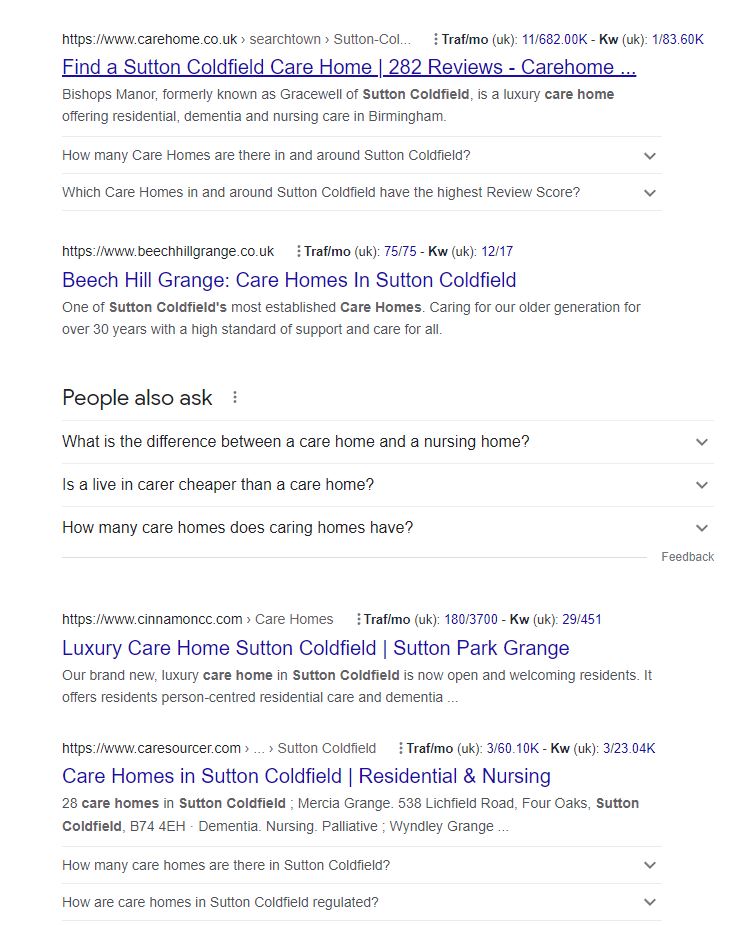
To effectively target these localised organic listings, you want to first get your location signals in place with the local SEO tactics mentioned above.
Note: Increased keyword scope
Local SEO is very much focused on what you do and where you do it. So, from a keyword perspective, it is somewhat simple: care home <location>.
Organic SEO is a little different and you can optimise for a far wider range of keywords.
This can relate to service areas, types of care, and much more.
Ultimately, this is an opportunity – if there is something you do well or service you provide, create and optimise a page for it.
The main jobs for organic SEO are:
- Ensure you clearly talk about the locations you cover
- Comprehensively detail the services you provide
- Make sure that key SEO on-page elements are optimised (page titles, descriptions, H1, body copy, etc)
- Strive to ensure you are listed and ideally linked from any relevant sources
The search engine does not know what you do if you don’t add it to your pages so make sure you have a comprehensive overview of everything your home provides.
Then, make sure this is all sensibly optimised for all the ways in which your target audience may search.
SEO is mostly common sense – speak in the language of your customers and don’t overcomplicate it.
6. SEO & PPC for Multiple Care Homes
If you are part of a larger care home group and have multiple locations, this can be an asset when configured correctly.
The main jobs you need to do here from an SEO perspective are as follows:
- Build a page for each home that clearly outlines services and service area
- Ensure location pages and services exist in a sensible hierarchy
- Avoid too much duplication between homes
- Link your Google Business Profile listings to each location page
- Optimise all of your Google Business Profiles for each location
- Ensure NAP and citations are accurate for each location *
- Build backlinks to the main site
- Build local backlinks to the location pages
For PPC, this is a lot easier:
- Where possible, link location-based PPC campaigns to the relevant local page
- Ensure your analytics is configured to provide clear attribution
When optimising for multiple care homes, you really just have a superset of the standard SEO and PPC tasks. There is more opportunity, particularly on the SEO side, but you must optimise carefully and with careful attention to detail.
Problems with multiple location SEO for care homes
Whilst, in general, having multiple homes is a win, allowing you more overall authority, there are some issues where the added complexity can cause issues.
NAP issues – One problem with SEO and local SEO with any multi-location business is that there is more scope for things to go wrong with the NAP and there is just more data out there to trip Google up and confuse matters. You must be absolutely focused on having a well-optimised and consistent NAP.
Duplication issues – Where there are multiple homes it is easy to end up with a lot of duplicate information on your site. Avoid this by having single service pages and then linking the location pages to relevant services.
Structural issues – A larger site is a more complex site so the structural organisation of your site is more important. Think of your site like a filing cabinet and ensure you have a well-structured site with a clear taxonomy.
- Home
- Services
- Service A
- Service B
- Service C
- Homes
- Home A
- Home B
- Home C
- About
- Contact
- etc
Multi-location summary
Multi-location SEO for care homes should just build upon what you already have in place.
For SEO, this should give you more authority overall and make ranking easier. However, you do need to be mindful of increased complexity in your local SEO, on-site SEO, and off-site SEO.
For your PPC, you will just want to ensure you create localised ad groups and take advantage of your local landing pages.
7. Supportive Tactics
SEO and PPC are easy, right?
A user searches on Google, sees your advert or organic listing, clicks, and then converts. Wonderful.
If only digital marketing were that simple.
The reality here is that whilst SEO and PPC will drive traffic with a solid intent, converting often takes more than a single engagement.
The tactics here will help you stay in front of prospective customers and educate them as to why your care home is the best choice.
Supporting tactics for SEO and PPC
For clarity – our goals here are to build the brand, educate prospects on why they should choose your care home, and bring people back to the site.
We do all of this to increase overall conversion rates.
To do this, there are a few key tactics that we will want to have in place to ensure your SEO and PPC deliver the best possible return.
The following are our recommendations:
- Remarketing – remarketing using Google Display ads (banners) and social media can help with brand awareness and engagement
- Display advertising – showing ads to people who have searched for your keywords but not clicked can help feed the top of your funnel
- Lead magnet – I am a fan of creating a lead magnet and then promoting that to build brand awareness and top-of-the-funnel visibility
- Email marketing – if you build leads using a lead magnet, staying in touch via email is a powerful nurturing tool
- Social media – social provides a shop window and helps people get a more tactile feel for how you operate
The specifics here can vary based on your home and goals but the point remains the same – SEO and PPC work best when they are teamed up with other tactics.
Get in touch for a free marketing review to find out where your digital marketing gaps are!
8. Conversion Rate Optimisation
A key digital tactic that is all-too-often overlooked is conversion rate optimisation (CRO).
CRO is the process of improving the percentage of visitors that convert when they come to your website.
Conversions are typically anything that we want our marketing to drive, so:
- Brochure requests
- Visit requests
- Phone calls
- Emails
- Live chats
Generally, leads or at least a strong interest in the care home.
The importance of CRO
It is really very hard to overstate how important CRO is for the overall success of your digital marketing program.
Whatever your goals or challenges, it is highly likely CRO can help.
- Reducing your marketing costs or CPC budget
- Reducing your cost per lead
- Improving your ROI
- Improving the total number of leads
As a simple example, imagine your website has a 1% conversion rate of visits to enquiry.
Often, the thinking in SEO and PPC is kind of a more, more, more mentality.
More traffic, more PPC, more SEO, more social.
More money, more time, more effort.
A miserable approach.
It is also often impossible or prohibitively expensive to double viable SEO or PPC traffic in any short measure for a local business with a geographic catchment area.
This is where CRO comes in
If you can take your conversion rate from 1% to 2% you can double your leads or halve your costs.
Then, if you can take that further and improve your conversion rate to 4%, you can double your leads and halve your costs.
The outcome here is that if you keep pushing that conversion rate up, your cost per lead goes down, and your leads go up.
Another key fact here is that if you can generate leads at a lower cost than your competitors then you can outgun them in every channel.
If you convert at 5% and your competitors convert at 1%, it costs you 20% what it costs your competitor to generate a lead.
You can then dominate any paid tactics.
The best part of all is that this is often very achievable.
For more details on exactly how to do this read our Beginner’s Guide to Conversion Rate Optimisation (CRO).
Or get in touch for a free conversion rate audit.
9. Measuring Results
The final piece in the SEO and PPC puzzle is measuring results.
To do this you will need to ensure you are tracking anything important that happens on your website as a goal in Google Analytics and as a conversion in Google Ads.
The specifics will vary based on your site, but, in general, you should be tracking all downloads and forms of enquiry:
- Phone number clicks
- Email clicks
- Contact forms
- Downloads
There are a number of ways to do this, but we would typically recommend doing this in Google Analytics and Google Tag Manager.
For more details on what to track and how to implement this tracking, review our Beginner’s Guide to Conversion Rate Optimisation.
If you are struggling or would like some help, please drop a comment below or get in touch.
SEO KPIs
What we are trying to do here is track three key areas:
- Visibility – where you rank on a search engine
- Engagement – the traffic that you receive
- Conversions – how that traffic performs
To do this, we will track the following SEO KPIs:
- Keyword rank tracking *
- Geographic areas sending traffic
- Organic traffic
- Organic rankings
- Google Business Profile insights (listings on search, listings on maps, customer actions)
- Organic impressions (Google Search Console)
- Organic CTR (Search Console)
A note on rank tracking
One area to be mindful of here is keyword rank tracking and how rankings fluctuate over a geographic area.
Typically, if you search for “care homes” whilst you are at work you will see an overly positive result as you are physically so close to your location.
Generally, the further you get from your location, the worse your rankings can be, so it is important to track your rankings at a number of points over your target area.
There are several tools out there, one of which is the Local Search Grid from BrightLocal that we tend to use at Bowler Hat.
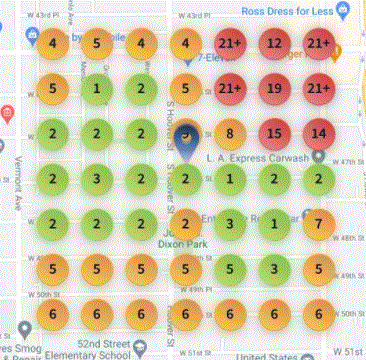
This approach gives you much more clarity with regard to your strengths and weaknesses so you can refine your approach.
Likewise, if you are using SEO and PPC, you may want to pay particular attention to areas with your Google Ads PPC where your organic search visibility is not so strong.
An agency may track several other SEO KPIs that help provide more technical diagnostics, but for your average care home, these SEO KPIs are a great start.
The following links can provide some more input on rank tracking and SEO tools:
Google Ads PPC KPIs
Google Ads PPC is a treasure trove of information for marketing your care home and the following are some of the key metrics to track:
- Impressions – the number of times your ad was displayed
- Clicks/interactions – the number of clicks your ad received
- Interaction rate – interactions divided by impressions (higher is better)
- Conversions – all of your goals in Google Analytics imported into Google Ads
- Cost per conversion – the average cost of one of your primary conversions
Beyond these basic PPC KPIs, I would suggest tracking the following competitive metrics:
- Search impression share – how often your ad showed vs how often it could have shown
- Click share – total clicks divided by the total clicks you could have had
- Search top IS – how often your ad showed in the top set of ads
- Search abs. top IS – how often your ad showed in the very first ad spot
You may also want to track some of these metrics at a campaign, ad group, ad, and keyword level if you really want to get granular in your analysis.
These metrics will really help you understand how well your ads are performing and where there is room for growth.
Keeping track over time
Finally, something that tends to help here is to keep these KPIs in a spreadsheet with a column for each month.
If you create a rule so your cells are either red, orange, or green depending on performance then you can easily spot trends in different metrics.
10. Summary and Next Steps
If you have made it this far, then you should have a far greater understanding of the best way to market your care home on Google using SEO and PPC.
We have worked with several care homes over several years and have experience with big, small, and national chains and this article is the distillation of that experience.
If you have any questions on how to improve the SEO or PPC for your care home then please drop a comment below or get in touch.
Free consultation and SEO/PPC plan
If you would like some guidance on how to improve your care home’s SEO and PPC, please get in touch.
Resources
We have a few resources to help you here and get in touch to request any of the following:
- Keyword research spreadsheet
- Care home SEO checklist
References and further reading
- Google Ads Keyword Planner
- Keywords Everywhere keyword research tool
- Google Ads – The 4 Key PPC Success Factors
- SEO Tools – Do You Need Them?
- How to Check Your Website Rankings on Google
Glossary
- NAP – name, address, phone number (also usually website address) – important for local SEO
- GMB – Google My Business (the old name of Google Business Profile)
- GBP – Google Business Profile
- PPC aka pay-per-click – a form of marketing where you only pay when a user clicks your ad
- SEM aka search engine marketing – typically paid ads shown on a search engine like Google
- SEO aka search engine optimisation – helping improve visibility of your website on search engines
- Local SEO aka local search engine optimisation – SEO for local businesses targeting maps and map listings on a search engine
- CRO – conversion rate optimisation – increasing the percentage of visitors that take a desired action on your website


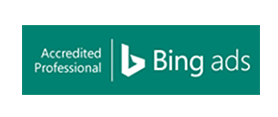




One Response
I read multiple articles and this is certainly one of the best and productive content I found. Thanks for sharing the useful article.